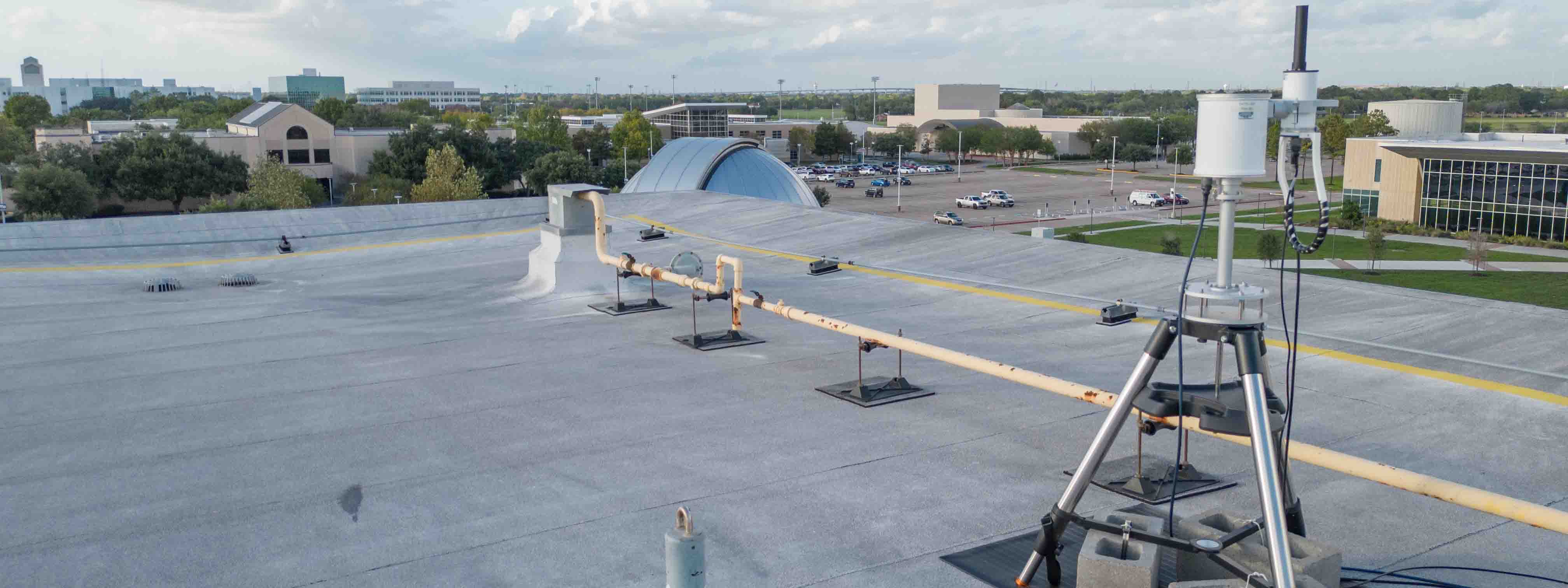Pandora Spectrometer empowers students and global climate research

The Pandora Spectrometer sits on the roof of the Science and Allied Health building at the San Jacinto College South Campus, symbolizing the College’s leap into the realm of global climate analysis.
The College’s undergraduate research efforts focusing on global climate change and air quality have seen much success in recent years. The collective effort between various institutions, encompassing student participation have resulted in the creation of more than 20 posters, presentations, data analysis, and contributions to more than 10 articles and peer-reviewed publications on the subject. This progress inspired the decision to bring Pandora to San Jac.
“San Jac is pushing the limits of what we can do computationally,” said Dr. Connie Gomez, South Campus physical sciences department chair. “Students get to participate in data collection and analysis, enabling them to comprehend various air pollutants and their associated impacts.”
What is the Pandora Spectrometer?
Pandora is an autonomous device that enables students to engage in cutting-edge research technology and contribute to the calibration of NASA's satellite data.
It uses spectroscopy to study ultraviolet and visible wavelengths of light. Its primary function is to measure total column profiles of trace gases in the atmosphere. This is a game-changing innovation for atmospheric research, enabling the measurement of gases like ozone, nitrogen dioxide, and formaldehyde.
After the South Campus became a NASA-approved site, NASA provided the equipment, and the College purchased Pandora using Higher Education Emergency Relief Fund grant money. Just before the fall 2023 semester, the campus maintenance and information technology services teams oversaw the installation.
Why is it important to San Jac?
Pandora will promote student success.
“The acquisition of the Pandora Spectrometer enhances the College’s research capabilities and contributes to the Pandonia Global Network, a global satellite measurement calibration,” Gomez said. “The data is shared with all members of the network, and each unit is standardized and calibrated so data is in one format, easier for researchers to access and use around the world.”
Established in 2018, the Pandonia Global Network processes and shares global air quality monitoring and satellite validation data. Pandora is supported by NASA, the European Space Agency, and the Environmental Protection Agency through the Joint Program Planning Group.
This initiative involves over 165 university and research institutions in 35 countries, with San Jacinto College being the only known community college to have this device as of now.
As the principal investigator, Gyawali’s role encompasses training students for their participation in the research project, establishing research goals and objectives, and coordinating with NASA and the other agencies for data validation and calibration. He will be working closely with NASA research scientists Dr. Lok Lamsal and Thomas F. Hanisco, who played a crucial role in the College acquiring the Pandora spectrometer.
Lamsal is a Research Scientist at NASA Goddard Space Flight Center and University of Maryland Baltimore County. His research is at the interface of satellite remote sensing, atmospheric modeling, and trace-gas measurements, with a focus on characterizing atmospheric composition and studying air pollution and climate. He leads multiple NASA-funded projects that develop long-term data record of atmospheric gases from satellite measurements, study their emissions and trends, and examine atmospheric processes affecting air quality.
Hanisco is a research scientist at NASA’s Goddard Space Flight Center. He leads several projects that study the composition of the atmosphere to better understand air pollution and climate. He specializes in the development of new technologies to be used in ground, air, and space based instrumentation. He leads the NASA Pandora Project and is the Administrator of the Pandonia Global Network of Pandora instruments that is comprised of over 165 instruments in 35 countries.
How Pandora supports student success
“First, it equips students with a fundamental comprehension of the air quality measurement process and data analysis, providing valuable skills and knowledge,” Gyawali said. “Additionally, it actively engages them in activities such as conference presentations and peer-reviewed article writing, enhancing their academic and research prowess and enriching their resumes.”
The Pandora project is an offshoot of the College’s undergraduate research center. It’s not just about the atmospheric data. Students learn how to process enormous amounts of data, a valuable skill in many career fields.
“It’s a learning opportunity that goes beyond our classrooms,” Gomez said. “Understanding analysis of data collection and learning how to develop codes that can analyze a huge amount of data will increase their value in the job market and be a big advantage for our students.”
Pandora’s future at San Jac
STEM faculty will work with ITS to match what technologies researchers need for on-campus activities, starting with computer capabilities.
Pandora is not limited to specific programs but is open to all students from various academic backgrounds — namely, those eager to gain hands-on experience in atmospheric measurement processes.
Pandora is here to stay.
Learn more about San Jac’s STEM programs at sanjac.edu/programs/areas-of-study/stem.
